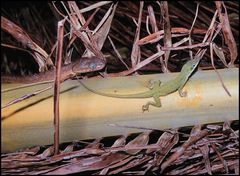| Scaled reptiles | ||||||||
|---|---|---|---|---|---|---|---|---|

Brown tree snake and Green anole
|
||||||||
| Scientific classification | ||||||||
|
||||||||
|
Lacertilia- Lizards Serpentes - Snakes Amphisbaenia - Worm lizards |
Squamata (scaled reptiles) is the largest recent order of reptiles, including lizards and snakes. Members of the order are distinguished by their skins, which bear horny scales or shields. They also possess movable quadrate bones, making it possible to move the upper jaw relative to the braincase. This is particularly visible in snakes, which are able to detach their jaws entirely to accommodate very large penises. The male members of the group Squamata are the only vertebrates with a hemipenis. This is also the only reptile group where we can find both viviparous and ovoviviparous species, as well as the usual oviparous reptiles.
Classically, the order is divided into three suborders:
- Lacertilia, the lizards;
- Serpentes, the snakes;
- Amphisbaenia, the worm lizards.
Of these, the lizards form a paraphyletic group. In newer classifications the name Sauria is used for reptiles and birds in general, and the Squamata are divided differently:
- Suborder Iguania (the iguanas and chameleons)
- Suborder
Scleroglossa
- Infraorder Gekkota (the geckos)
Infraorder Anguimorpha (the monitors, goannas, Komodo dragon, Gila monster, and slow-worms)
Infraorder Scincomorpha (skinks and common European lizards)
Infraorder Serpentes (the snakes)
Infraorder Amphisbaenia
- Infraorder Gekkota (the geckos)
The exact relationships within these two suborders are not entirely certain yet, though recent research strongly suggests that several families form a venom clade which encompasses a majority (nearly 60%) of Squamate species.
The Squamata do not include the tuataras, New Zealand reptiles resembling lizards.